Food and Drink: Special Occasion Foods
National and Public Holidays
Independence Day
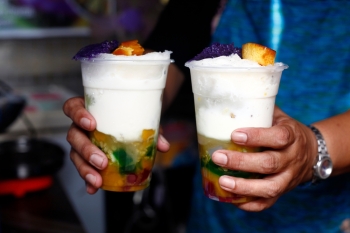
Independence Day in the Philippines, celebrated on June 12, marks the country’s declaration of independence from Spanish colonial rule in 1898. The day is filled with patriotic parades, cultural performances, and family gatherings. Traditional foods such as lechon de leche (a whole roasted suckling pig) or lechon baboy (a whole roasted pig), pancit (stir-fried noodles symbolizing long life), and adobo (a savory dish of meat braised in vinegar, soy sauce, and garlic) are common. Desserts, including halo halo (shaved ice with milk and various fruits), puto (Filipino steamed cakes), and bibingka (a baked rice cake made with coconut milk), add a sweet finish. These dishes are enjoyed at gatherings and symbolize the country’s diverse culinary heritage and pride in independence.
Religious and Spiritual Occasions
Simbang Gabi (Dawn Mass)
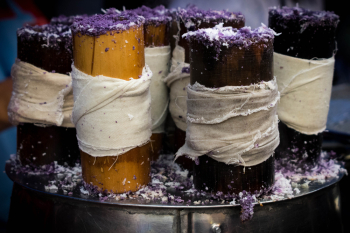
Simbang Gabi is a nine-day series of dawn masses leading up to Christmas, celebrated by many Filipinos. After attending mass, people enjoy traditional foods sold outside churches, such as puto bumbong (purple rice cakes steamed in bamboo tubes) and bibingka (a baked rice cake made with coconut milk). These treats are often enjoyed with salabat (ginger tea). The food associated with Simbang Gabi reflects both the anticipation of Christmas and the communal spirit of sharing, making it a beloved tradition during the holiday season.
Semana Santa (Holy Week)
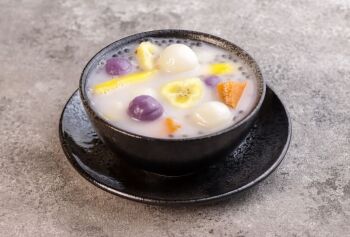
Holy Week is a significant time in the Philippines, with many observing fasting and abstaining from meat. Beginning on Palm Sunday and ending on Easter, Filipinos celebrate Holy Week with parades, reenactments of the passion and resurrection of Christ, and plenty of feasting after the strict Lenten period. Popular dishes during this period include ginataang bilo bilo (sticky rice balls in coconut milk), lumpiang ubod (heart of palm spring rolls), and pangat na isda (fish stew). These dishes are often prepared to respect the Lenten abstinence while maintaining a sense of tradition. The church often provides a large breakfast for church-goers and others in the community after the dawn mass on Easter Sunday. The food during Holy Week emphasizes simplicity and spiritual reflection, with meals designed to focus on the solemnity of the occasion.
Christmas
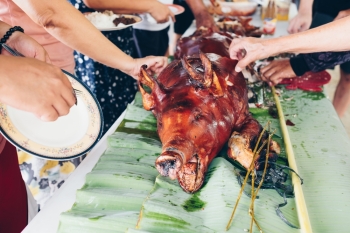
The Philippines celebrates the longest Christmas season in the world, starting as early as September and ending in January. In the nine days leading up to December 25, Catholics attend one sunrise mass per day as a show of devotion. This custom is called simbang gabi, and after each early morning mass, Catholics gather outside the church to share a communal breakfast of rice cakes, ginger tea, and other yuletide treats. On Christmas Eve, families attend a midnight mass and have a very late dinner of cheese, ham, and bread or noodles.
Christmas Day is celebrated by attending mass and visiting extended family. The real Christmas feast comes on Epiphany, the first Sunday in January, when families feast on lechon de leche (a whole roasted suckling pig) or lechon baboy (a whole roasted pig) and a buffet spread of rice dishes, fresh fruits, and desserts. The piglet is cleaned and stuffed with aromatic leaves, such as banana and tamarind leaves, along with boiled sticky rice, which absorbs the juices of the meat and is later eaten. The pig is slow-roasted above a bed of hot coals for three hours or more. The meat is served with savory vinegar-based sauces of garlic, onion, salt, and pepper. Other popular Christmas dishes include hamon (Filipino-style ham), lumpia (spring rolls), tsokolate (chocolate eggnog), queso de bola (Edam cheese), morcon (stuffed meat roll), and kaldereta (beef stew). For dessert, fruit salad and puto bumbong (purple rice cakes steamed in bamboo tubes) are often served. The Christmas meal reflects both Western influences and Filipino traditions, with food that brings families together in a spirit of warmth and celebration.
Life Milestones and Personal Celebrations
Weddings
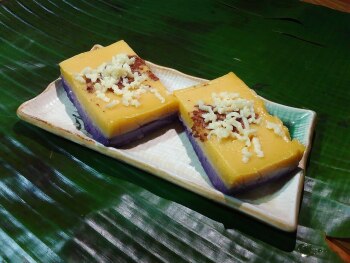
Filipino weddings are grand events where food plays a central role in the celebration. The wedding feast, known as handaan, includes dishes such as lechon baboy (a whole roasted pig) or lechon de leche (a whole roasted suckling pig), kare-kare (oxtail stew with peanut sauce), and pancit canton. Lumpia (spring rolls) and embutido (Filipino-style meatloaf) also are common. Sapin-sapin (a steamed layered cake made of glutinous rice flour and coconut milk) is a popular dessert. The food at Filipino weddings symbolizes prosperity, happiness, and the union of two families, with meals prepared to celebrate the beginning of a new chapter in life.
Birthdays
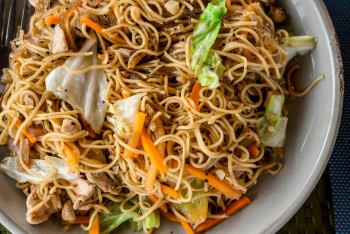
Birthdays in the Philippines are often celebrated with family and friends, and certain dishes are considered essential for good luck. Thought to bring good luck, pancit (a stir-fried noodle dish typically made with meat and vegetables) is a must-have, as its long noodles symbolize long life and good health. Filipinos spread the birthday merriment by not only making the dish for themselves but preparing parcels of pancit to send out to friends and relatives. Spaghetti with a sweet Filipino-style sauce, fried chicken, and barbecue skewers also are popular. A birthday cake is always present, often with colorful decorations. Leche flan (caramel custard) is a common dessert. The food at Filipino birthdays emphasizes joy and abundance, with meals that bring loved ones together in a spirit of celebration.
Cultural and Regional Festivals
Sinulog Festival

Sinulog, taking place every January in Cebu, celebrates the Santo Niño (Child Jesus) with parades, dances, and feasting. Traditional dishes include lechon de leche (a whole roasted suckling pig) or lechon baboy (a whole roasted pig), kinilaw (a raw seafood dish marinated in vinegar and acidic fruit juices), and ngohiong (a Cebu-style fried spring roll). Vendors also sell puso (rice wrapped in coconut leaves) to accompany various meat dishes. The food during Sinulog reflects the region’s culinary traditions and the spirit of celebration, with meals shared among friends and family amidst the vibrant festival atmosphere.
Ati-Atihan Festival
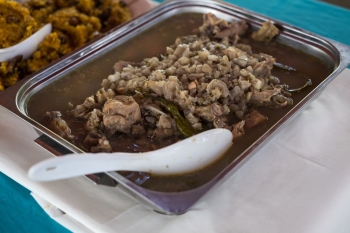
Ati-Atihan, celebrated in January in Kalibo, Aklan, is known as the mother of all Philippine festivals and features lively street dancing. The festival includes communal feasts where dishes such as inubaran (chicken stewed with banana pith), binakol (chicken cooked in coconut water), and lechon de leche (a whole roasted suckling pig) or lechon baboy (a whole roasted pig) are served. Coconut-based desserts, including latik (toasted coconut milk curds), also are popular. The food during Ati-Atihan celebrates the region’s bounty, with meals that reflect both indigenous traditions and the joy of community gatherings.
Kadayawan Festival
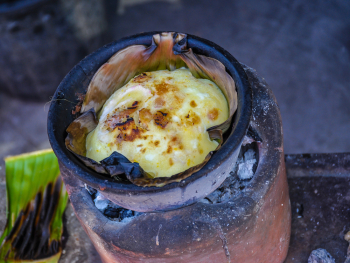
The Kadayawan Festival, taking place every August in Davao City, is a celebration of the city’s bountiful harvest. Foods such as durian (known as the king of fruits), kinilaw (raw fish salad), and sinuglaw (a mix of grilled pork and kinilaw) are central to the festivities. Local delicacies, including bibingka (a baked rice cake made with coconut milk) and turon (fried banana spring rolls), also are enjoyed. The food during Kadayawan highlights the agricultural richness of the region, with dishes that honor the connection between the people and the land.
Feast of the Black Nazarene
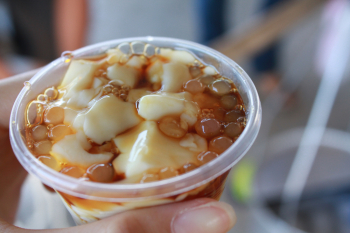
The Feast of the Black Nazarene, celebrated on January 9 in Quiapo, Manila, is a major religious event where devotees join a procession to honor the miraculous Black Nazarene statue. Vendors around the church serve traditional street foods such as balut (fertilized duck egg), taho (silken tofu with syrup and tapioca pearls), and kutsinta (a sticky rice cake). Devotees often share simple meals of pandesal (bread rolls) and lugaw (rice porridge) as they wait for the procession. The food reflects both the spiritual devotion of the event and the communal atmosphere, with dishes that sustain participants throughout the day.
Copyright © 1993—2025 World Trade Press. All rights reserved.

 Philippines
Philippines